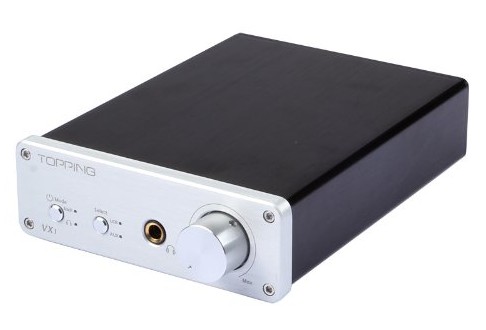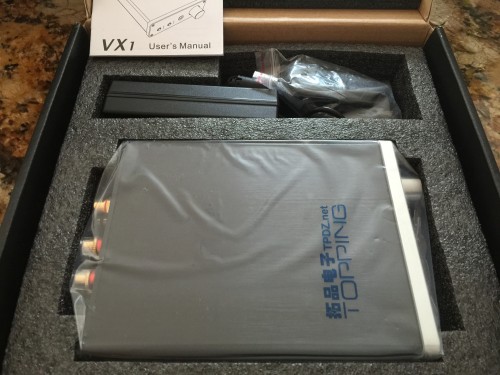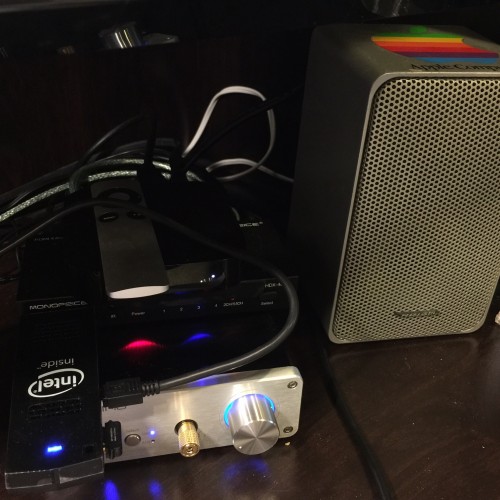A few months back, I asked folks on Twitter and LinkedIn for recommendations for a desktop amplifier for a pair of bookshelf speakers. I ended up with a Topping VX1, one of the many “Class-T” digital amps lauded by audiophiles for their excellent sound reproduction. Boy am I impressed! It’s rare that such an inexpensive gadget (around $100!) delivers so much performance!

When I’m in the office, I usually keep it silent so I can work. But sometimes I like to have music playing, and when I do I want it to sound good. Although I’m no audiophile, I can’t stand tinny, fuzzy audio, and this means I need a real amplifier and speakers. Since I already had a pair of decent Boston Acoustics speakers, I set about finding a good amplifier to pair with them.
Desperately Seeking Amplification
Although I have an older full-size stereo receiver I could have paired with the speakers, I wanted something smaller and simpler on my desktop. And although I could have simply plugged a headphone-style cable into my laptop to send audio into the amp (or used Apple AirPlay), I really wanted something that would integrate cleanly with my USB3 “dock”. And I didn’t want to spend a ton of money or build a whole new audio solution (sorry, Sonos!)
The Topping VX1 hits all the requirements I had:
- It’s compact, about the size of a thick paperback book
- It’s cheap, at just over $100 shipped from Amazon
- It has an integrated USB audio converter as well as a standard aux input jack
- It’s made to drive both full-size speakers and headphones
- Topping uses high-quality components inside and out for excellent audio performance
Seriously, this thing is fantastic. Just as reviewer after reviewer has claimed over the last decade, the “Class-T” amplifier is phenomenal. Clear, detailed, and above all flat, this amplifier is every bit as good as whatever source material you send into it. Maybe some high-end amp can beat it, but there’s nothing in this price range that compares.

Tripath Class-T Amps
Let me geek out a bit about the chip that powers this amp. Back in the 1990’s, switching digital amplifiers (“Class-D”) appeared, but none could really offer audiophile-level accuracy. In fact, despite widespread use, classical digital amplifiers produce fairly poor sound quality. This is why most decent home amplifiers still use a simple, inefficient, but proven Class A design with analog transistors or even vacuum tubes.
In 1998, Tripath “shook the world” with their TA2020. They added a variable-rate sampling system that dynamically adjusts the amplifier switching rate to the input signal. This resulted in an efficient digital amplifier that matched or beat most analog amplifier designs. And the Tripath chip was cheap, spawning a world of audiophile digital amplifiers. But Tripath’s success was short, with a 2007 bankruptcy being followed by an acquisition by chip giant Cirrus Logic.
Today, Tripath chips have retained their cult following. Although inexpensive and of varying quality, Tripath amps are sought after and exhaustively tested and modified. It’s really an interesting corner of the electronic/audio geek world!
Topping VX1
Perhaps the best of the current crop of inexpensive Tripath-powered amplifier makers is Topping. They’re known for using high-quality components to maximize the potential of the “little amp that could” and it really shows!

The Topping VX1 is a desktop or bookshelf amplifier with stereo speaker and headphone outputs and integrated USB and aux input jacks. It uses a quality Cirrus Logic digital volume control (one of the weakest points of most cheap amps) and decent Burr-Brown DAC and op-amp. All of this is packed into an all-aluminum chassis with a nice machined aluminum faceplate and (too-bright) blue LED indicators.
The VX1 can be connected to a Mac or PC over USB, bringing its integrated Burr-Brown PCM2704 DAC to bear. This component is better than what you’d find in most computers or USB audio cards, and does a wonderful job with music sources. It’s automatically detected by Mac OS X and Windows, presenting a true plug-and-play experience.
I love how the Topping VX1 “becomes” my audio output as soon as I plug my MacBook Pro into my USB hub at home. I’ve also got Gigabit Ethernet, a Drobo, and an ioSafe backup drive connected to the Satechi 10-port USB3 hub I’ve previously mentioned. Everything works perfectly.
I love that the Topping can be used with analog sources as well, giving it serious longevity beyond current computers and operating systems. It would be nice if it also included an S/PDIF digital input, and I’d love a preamp or per-input volume control. But neither of these are a must-have.
Stephen’s Stance
If you’re looking for an affordable but high-quality music experience for your desktop or bedroom, you can’t beat the Topping VX1. Pair it with a decent set of speakers and you’re golden! I had good luck with the famed Radio Shack Minimus 7 speakers, but it sounds better with a larger speaker like the full-range Boston Acoustics CR55 I’m using.
Note: Many of these links go to Amazon with an Associates tag so I get a cut if you buy one of these things
Quick question: does your VX1 amplify sound that’s coming through the AUX input? Cause I’ve gone through two of these now, and while the USB worked fine, for both units the sound was actually weaker when routed through the amplifier to headphones via the AUX input as opposed to directly connecting headphones to the audio source. What gives? Did I just get two lemons or does the VX1 not amplify when using the AUX input?